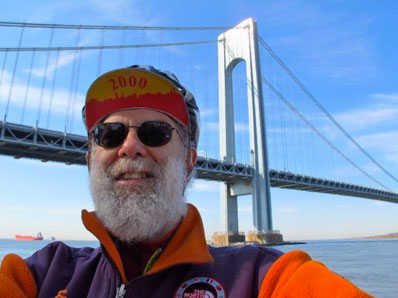On Saturday, longtime local bike advocate Steve Faust died at the age of 67. A New Yorker born and bred, Steve played a key role in many early fights for safer streets and bike access on city bridges, and continued to work for a bike path on the Verrazano Bridge in recent years through the Harbor Ring committee. We're going to miss him and the illuminating history lessons about NYC cycling that he was known to unspool in the Streetsblog comments.
A memorial for Steve Faust was held yesterday on the Upper West Side. In tribute to Steve's contributions to bicycling in New York City, we're publishing an excerpt from the prepared remarks his friend Steve Bauman delivered at the service.
Steve collaborated with many different people. I shall concentrate on only what involved me personally. It would take many volumes to document Steve's biking advocacy. My association with Steve coincides with the beginning of the urban-based bicycle movement.
The Beame administration's attitude is illustrated by two examples. Their DOT representative declared that the stenciled word “bikes” on an asphalt path adjacent to the Belt Parkway a rogue operation. That path was really an access road for DOT maintenance vehicles. They also tried to prohibit all bicycle parking on sidewalks.
Koch's election was a turning point because his administration was willing to meet and listen to the bicycling community. The bicycling community responded to this challenge by participating in something called the Mayor's Bicycle Advisory Committee. Steve was a founding member. This was unpaid and did not rate a mention in the Green Book. A lot of good results emerged at first, until a powerful backlash set in.
Koch approved a request to turn the year old Five Boro Bike Tour into a mass event. Steve was away at school during the planning for the first one. He came back in time to help lead the ride.
He was back in town for the intensive planning needed to transform a 250 person ride into one for 2,500. The time from approval to the tour's premature departure from City Hall was 90 days. Steve was involved in most of the nitty-gritty work including naming the ride. He was instrumental in securing medical support for the ride. The ride's success was due in large part to Steve's tireless work.
The 5BBT had a deliberate subliminal message. That message was that bikes could also be used for transportation. It wasn't lost on the Koch Administration when the 1980 subway strike was imminent. The Bicycle Advisory Committee was in the middle of the City's planning for what became a two week long strike. Even the NY Times agreed that bicycles had saved the City from catastrophe during the strike.
The Koch Administration wanted to make some of the emergency bike facilities permanent after the strike. The 6th Avenue barrier bike lanes followed. They were a technical success. They also created a powerful backlash that the Koch Administration could not withstand. First news of their impending removal came during an out of town National Bike Summit Meeting.
It was a terrible defeat. The barrier bike lanes were not the only items affected.
At that time only two East River bridges permitted bicycle access -- the Brooklyn and Williamsburg.
The Brooklyn Bridge promenade had five flights of stairs that had to be negotiated. At first, the Koch Administration wanted to remove those stairs. That support collapsed after slight opposition following the barrier bike lane's removal. Steve was one of only a handful of people who successfully fought for more than two years to get those stairs removed.
That fight was carried out on many levels. The bridge was under Landmark Commission protection. The opposition claimed the stairs were a integral to the bridge design. Steve spent many hours researching the original documents to show that each stairway was built as an engineering compromise; two stairways had been removed in the 1890's and the original bridge design had no stairways.
Steve also discovered a loophole: requiring American Disability Act access. Steve wrote to state and federal highway officials trying to secure a definitive statement in support of this contention. ADA access is now accepted. Both George Washington Bridge paths will become ADA accessible, thanks to the precedent that Steve helped set.
I don't know why the City finally acquiesced on the Brooklyn Bridge. I don't know whether it was Steve's points or those by others. I do know they would not have acquiesced without Steve's effort.





